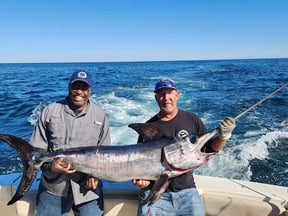We started Captain Experiences to make it easy to book fishing and hunting guides around the world. With over 1,500 Damn Good Guides, our platform makes finding and booking a trip seamless. Head here to check out our trips.
When Is It Too Windy To Fish Offshore?
Heading miles offshore on a sportfisher can be peaceful with good conditions, but if the wind picks up, it can get uncomfortable and possibly dangerous. Wind makes fishing more difficult in almost every way, and at some point, it’s not safe. Let’s take a look at how wind affects offshore fishing and how much wind is too much.

How Wind Affects Fishing
The open ocean has no protection from gusting winds, which means once it starts blowing, the water will get choppy. In a large boat like a sportfisher, the chop is usually no big deal, but fighting the wind means burning more fuel.
That being said, wind moves water, which stirs up organisms at the bottom of the food chain. This is typically followed by a feeding frenzy that runs up the food chain. When winds pick up, the bite also seems to pick up.
Ultimately, however, in too much wind it’s hard to keep baits running properly. Trolling surface lures becomes difficult because the wind and waves make the lure act erratically, which tends to attract fewer bites.
Wind and Waves
Although it can be hard to see, the wind has a big impact on water conditions. Wind moves water, creating currents that can weaken or strengthen tides and other currents. Ultimately, it comes down to how the wind affects the waves, which are more likely to threaten the boat. On its own, wind can push the boat off course, but doesn’t pose a safety hazard until wind speeds reach extreme levels.
When considering if there is too much wind to head offshore, looking at water conditions and wind speed will give you a better indication of what’s safe. To find the weather and water conditions look here.
Seas over three feet and far apart look like big swells that are easily navigated. But, when winds blow, the waves and chop begin to compress. The swells become waves from the added pressure of strong winds, which also have chop on top of it. As winds approach 20 knots, typical three foot seas go from smooth sailing to rough and unpleasant.
How Much Wind is Too Much
The weather conditions that can be fished or navigated will largely depend on what size boat you have. Bigger boats can generally handle rougher conditions before being in danger of swamping or capsizing. Offshore boats range from 30 to over 80 feet, and the difference in capability is significant. But, it’s always better to err on the side of caution.
As a general rule, anything over three foot seas with winds of 20 to 25 knots creates conditions that are no longer safe for fishing. Checking the distance between waves is also helpful, because if they are far enough apart, they are smooth. However, with winds approaching 25 knots, it’s unlikely that the waves will be small and spread out.
Have a Backup Plan
Ultimately, if you're going out on a guided deep sea fishing trip, your charter captain will closely monitor the weather conditions and make the right call on rescheduling the trip if it's unsafe.
At Captain Experiences, we have a 100% weather guarantee, so if your trip gets cancelled due to weather, we'll be sure to refund you—and get you rescheduled for a better day of fishing.
If you're ever offshore on your own in windy conditions and burn through your fuel as a result, Sea Tow is 24/7 priority on-water assistance. Their local captains are standing by to help. How far Sea Tow captains will go is only limited by sea conditions, fuel capacity of their boats, and the ability to communicate. If they can get there safely, they’ll be there. Because we all know Joe isn’t going to run 80 miles to deliver fuel!
Joey Butrus
Updated on July 31, 2023

October 26, 2020

March 8, 2022

April 15, 2022

January 19, 2021

August 1, 2022
Related Articles
April 13, 2022
April 10, 2022
March 31, 2023


